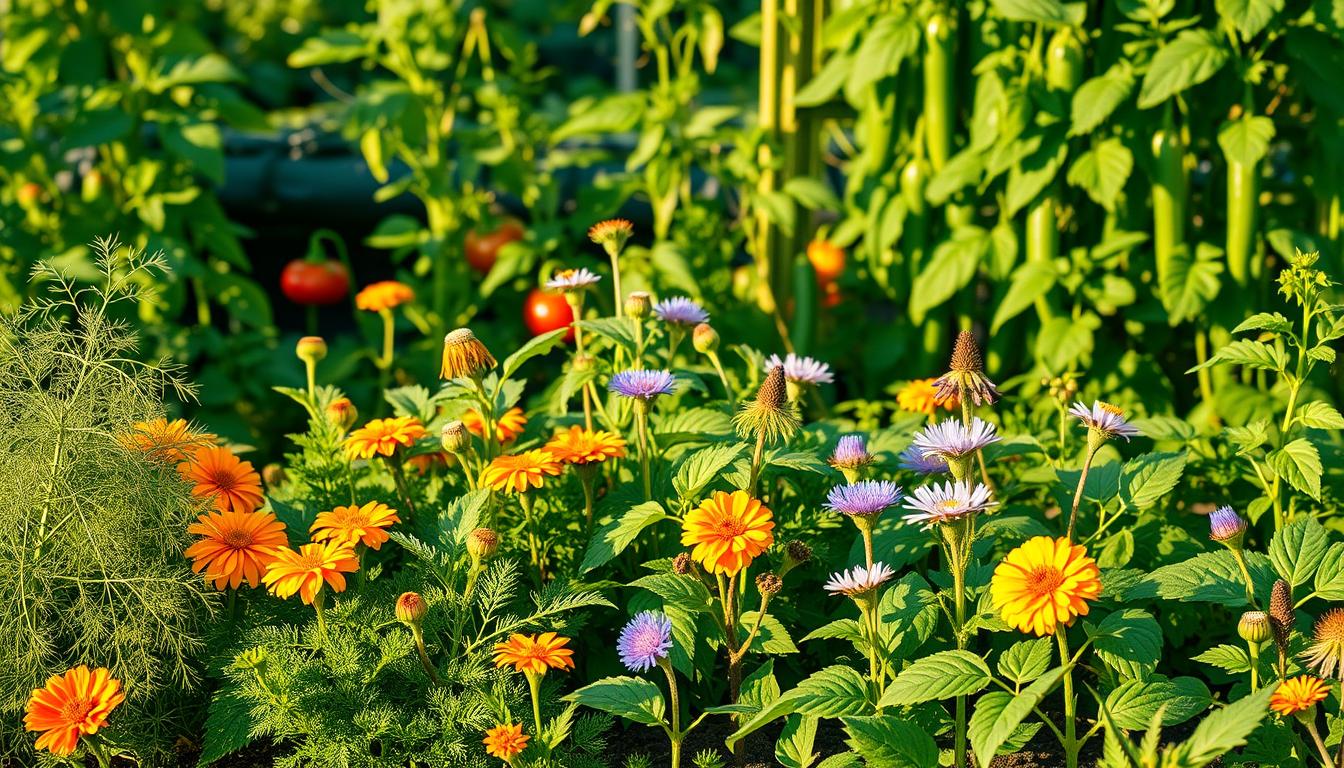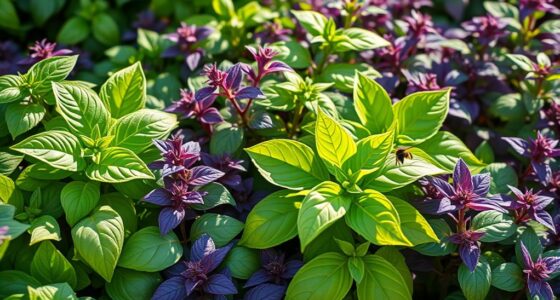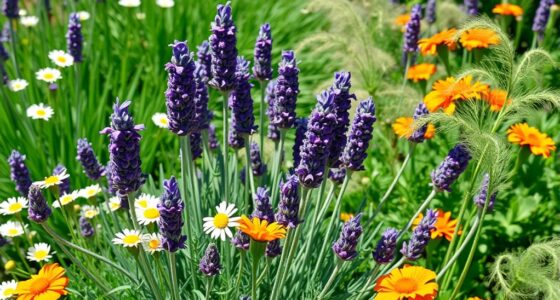Imagine walking into your garden and witnessing the vibrant symphony of plants thriving together, each one contributing to a healthier ecosystem. As the sun streams down, casting golden rays upon your cucumber plants, you can’t help but feel a sense of accomplishment. You’ve not only nurtured these green wonders but have also paired them with the best plants to grow with cucumbers, enhancing growth and deterring pests through the art of companion planting for cucumbers. The experience is not merely about reaping a bountiful harvest—it’s about creating a space where nature supports itself, flourishing in unity. Join us as we explore the world of cucumber companion plants and how they can transform your garden into an abundant paradise.
Key Takeaways
- Understanding cucumber companion plants can significantly improve yield.
- Strategically pairing plants creates a balanced garden ecosystem.
- Companion planting for cucumbers helps in pest control.
- Healthy soil and nutrients are vital for cucumber growth.
- Experimenting with different companions can yield great results.
- Knowledge of plant compatibility will enhance your gardening skills.
What Are Companion Plants for Cucumbers?
Understanding companion plants for your cucumber garden can transform your home gardening experience. Companion planting refers to growing different plant species together based on their ability to benefit each other’s growth. This practice not only enhances productivity but also fosters a harmonious ecosystem in your garden.
Definition of Companion Planting
Companion planting involves strategically selecting plants that support each other. This technique helps mitigate issues like pests and diseases while optimizing space. A cucumber companion planting guide typically suggests plant pairings that improve nutrient uptake and attract beneficial insects.
Benefits of Companion Planting
Utilizing companion plants yields various advantages, such as:
- Enhanced soil quality
- Boosted yield potential
- Attraction of pollinators
- Natural pest resistance
These benefits contribute to a thriving garden ecosystem, providing a nurturing environment for your cucumbers and their companions.
How It Works in Your Garden
Intercropping with cucumbers involves selecting companion plants that complement their growth cycle. For instance, planting marigolds nearby can deter harmful insects, while beans add nitrogen to the soil, indirectly benefiting cucumbers. By understanding these relationships, you can manage your garden’s health with minimal effort.

| Companion Plant | Benefits |
|---|---|
| Marigolds | Repel harmful pests |
| Beans | Add nitrogen to the soil |
| Radishes | Deter cucumber beetles |
| Dill | Attract beneficial insects |
Best Companion Plants for Cucumbers
When considering the best companion plants for cucumbers, you want to focus on options that provide benefits such as pest control, support, and improved growth. This section highlights several effective cucumber plant companions that you can easily integrate into your garden.
Marigolds and Their Benefits
Marigolds are a popular choice among gardeners due to their natural ability to repel cucumber beetles, which can wreak havoc on your plants. By planting marigolds near your cucumber plants, you can create a protective barrier that helps maintain healthy growth. This colorful flower not only adds beauty to your garden but also supports the overall health of your cucumbers.
Radishes: More Than Just a Side Dish
Radishes are more than just a tasty complement to salads. As one of the best companion plants for cucumbers, they can help deter pests while providing a quick harvest. Their growth rate allows you to plant them alongside cucumbers without worrying about overcrowding. Referencing a companion planting chart for cucumbers reveals that radishes thrive when planted nearby, enhancing both your vegetable yield and garden health.
Corn as a Towering Support
Corn serves not only as a delicious addition to your garden but also as an effective natural trellis for vining cucumbers. As cucumbers climb the tall stalks of corn, they benefit from the shade it provides, helping to maintain consistent moisture levels in the soil. This relationship exemplifies the advantages of incorporating a variety of plants into your garden, illustrating the importance of choosing the right cucumber plant companions for a flourishing garden.
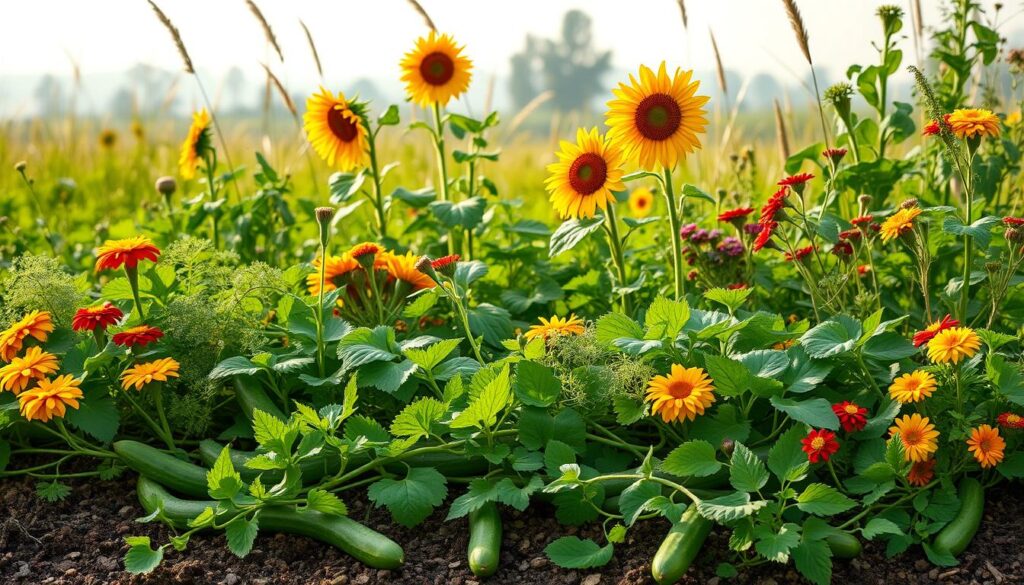
Herbs That Pair Well with Cucumbers
Enhancing your cucumber garden with herbs can lead to vibrant growth and improved pest management. Incorporating specific herbs for cucumber companion planting creates a balanced ecosystem that supports both flavor and function. The right combinations can help your cucumbers thrive while warding off potential pests.
Dill: A Flavorful Friend
Dill is not only a culinary favorite, but it also serves a critical role in your companion plants for cucumber garden. This herb attracts beneficial insects, such as ladybugs and lacewings, which feast on aphids and other garden pests. Its feathery foliage provides a natural habitat for these allies, enhancing pest control in a cucumber patch.
Basil’s Role in Pest Control
Basil offers more than just an aromatic addition to dishes; this herb is a powerful ally in the garden, known for its ability to repel pests like aphids and spider mites. Planting basil among your cucumbers can create a protective barrier, reducing infestations and promoting healthy growth. The sweet scent of basil can also confuse harmful insects, making it a smart choice for your cucumber bed.
Oregano vs. Cucumber: A Surprisingly Good Match
Oregano stands out as a surprising herb for cucumber companion planting. Its strong aroma not only enhances culinary dishes but also acts as a natural insect deterrent. The dense foliage of oregano can provide shade for cucumber roots, reducing soil temperature and moisture loss. This combination improves overall garden health, leading to a more robust cucumber crop.

Flowers That Enhance Cucumber Growth
Integrating flowers into your cucumber garden can significantly improve plant health and yield. The right flowers for cucumber companion planting can deter pests and attract beneficial insects. This cucumber companion planting guide explores various flowering plants that work harmoniously with cucumbers.
Nasturtiums: A Pest Deterrent
Nasturtiums serve as a natural repellent against common pests that threaten cucumber plants, including aphids and cucumber beetles. Their vibrant blooms not only brighten your garden but also lure pests away from your cucumbers. This combination of beauty and utility makes nasturtiums a fantastic addition to any companion planting scheme.
Borage: Attracting Beneficial Insects
Borage is another excellent choice for supporting cucumber growth. This flower attracts a variety of beneficial insects, such as bees, which play a critical role in pollination. Additionally, borage has deep roots that improve soil structure and nutrient availability. By including borage in your garden, you create a dynamic ecosystem that benefits cucumbers and ensures a bountiful harvest.
Sunflowers and Vertical Gardening
Sunflowers provide a sturdy vertical structure for your cucumber vines to climb, promoting better air circulation and sunlight exposure. This vertical gardening technique not only maximizes space but also contributes to healthier cucumbers. Pairing sunflowers with cucumbers fosters a thriving environment where all plants can flourish.
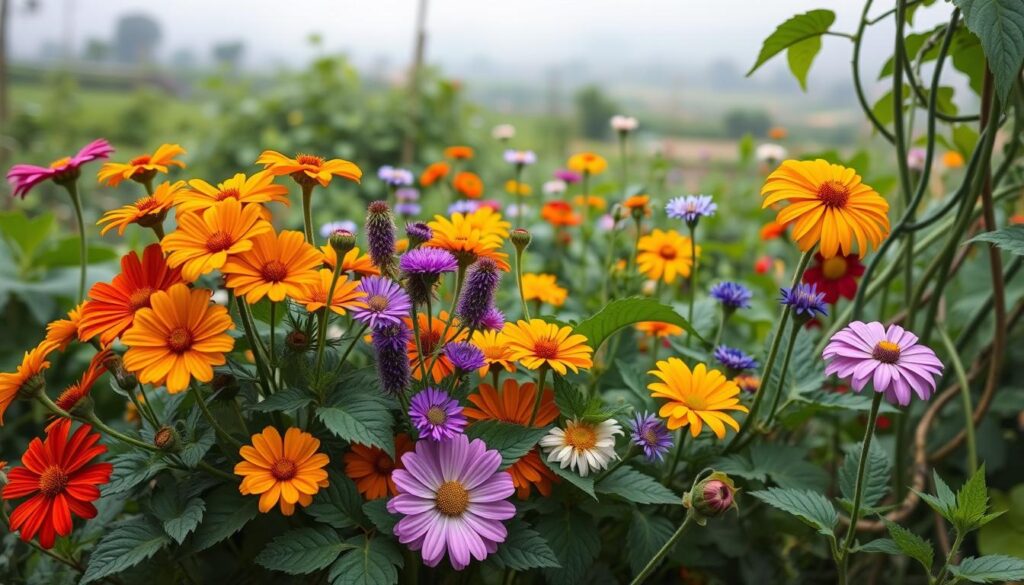
Vegetables That Thrive Alongside Cucumbers
Pairing cucumbers with the right vegetables can enhance your garden’s productivity. Understanding the ideal companions will help you create a thriving garden. Here we explore vegetables that grow well with cucumbers, highlighting how companion planting for cucumbers can benefit your overall yield.
Peppers: Spicy Companions
Planting peppers near cucumbers is a wise choice, as they add flavor without competing for essential nutrients. Peppers and cucumbers occupy different layers of soil, ensuring both plants flourish without overcrowding. This relationship allows you to maximize your garden space efficiently.
Carrots: A Rooted Relationship
Carrots thrive alongside cucumbers, fostering a harmonious relationship below the soil. As root vegetables, carrots do not interfere with the growth of cucumbers. Additionally, their underground activities can help aerate the soil, promoting healthy root development for both plants.
Beans: Nitrogen Boost for Your Cucumber
Beans serve as an excellent companion for cucumbers by fixing nitrogen in the soil. This natural fertilizer enriches the earth, giving your cucumbers an added boost. Pole beans, in particular, can climb trellises, maximizing vertical space while providing shade for the developing cucumber plants.

| Vegetable | Benefit | Growth Compatibility |
|---|---|---|
| Peppers | Flavor enhancement | Different soil layers |
| Carrots | Soil aeration | Non-competing roots |
| Beans | Nitrogen fixation | Vertical growth support |
Cucumber Planting Techniques
When it comes to successful cucumber cultivation, understanding the right cucumber planting techniques can significantly impact your yield. Two primary methods exist: sowing seeds directly in the garden or using transplants. Each has its advantages depending on your gardening style and environmental conditions.
Seed vs. Transplanting
Choosing whether to plant seeds or transplants depends on several factors. Direct seeding allows for a more natural growth process, while transplanting can give your cucumbers a head start. If you opt for transplants, select sturdy seedlings that are around four weeks old and have a healthy root system. Direct sowing is ideal when the threat of frost has passed and the soil temperature reaches 70°F or higher.
Choosing the Right Location
Location plays a pivotal role in cucumber growth. Identify a spot that receives full sun for at least six to eight hours daily. Cucumbers thrive in warmth and benefit from well-drained soil that holds moisture without becoming waterlogged. Following a cucumber companion planting guide can help you select the best planting sites and neighboring plants that promote their health.
Soil Preparation Tips
Preparing your soil correctly can set the stage for a bountiful cucumber harvest. Start by enriching the soil with organic matter, such as compost, to enhance fertility and drainage. Test the pH levels and aim for a slightly acidic to neutral range, ideally between 6.0 and 7.0. This approach will ensure your cucumbers receive essential nutrients, maximizing growth potential.
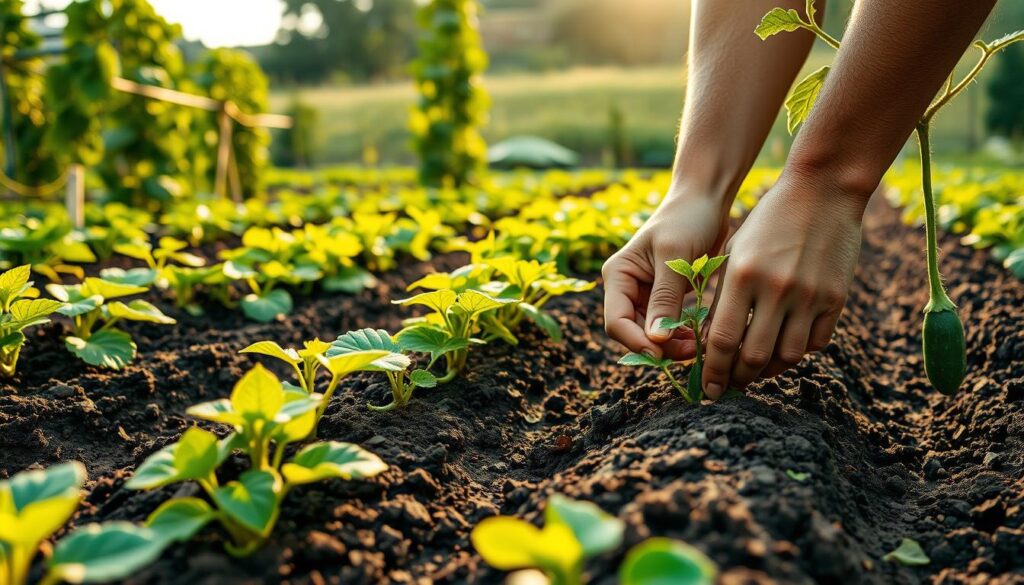
| Technique | Advantages | Considerations |
|---|---|---|
| Seed Sowing | Natural growth, less risk of transplant shock | Requires frost-free conditions, longer time to harvest |
| Transplanting | Earlier harvest, better control over growing conditions | Needs careful handling during planting, potential root disturbance |
Creating a Balanced Garden Ecosystem
A thriving cucumber garden benefits immensely from a balanced garden ecosystem. Biodiversity plays a key role in fostering a healthy environment, allowing plants to grow stronger and more resilient against pests and diseases. When you create this ecological framework, you support not only your cucumbers but also their companion plants, enhancing overall productivity.
The Importance of Biodiversity
Biodiversity within your garden helps establish a natural balance. Different plant species attract various beneficial insects and repel harmful pests. A diverse planting arrangement can minimize the reliance on chemical pesticides, leading to a healthier garden and environment. The coexistence of plants encourages a balanced garden ecosystem that fosters sustainability.
Crop Rotation Benefits
Implementing crop rotation in your cucumber garden significantly contributes to soil health. Changing the plant families in your garden each season avoids nutrient depletion and reduces the risk of disease. This practice allows the soil to replenish nutrients, promoting a balanced garden ecosystem that supports your cucumbers and their companions throughout their growth cycles.
Adding Organic Matter
Incorporating organic matter for cucumber gardens is essential for improving soil texture and fertility. Composts, well-rotted manure, and other organic materials enrich the soil, enhancing its structure and nutrient content. By adding organic matter, you create a more hospitable environment for beneficial microbes and earthworms, crucial for maintaining a balanced garden ecosystem.
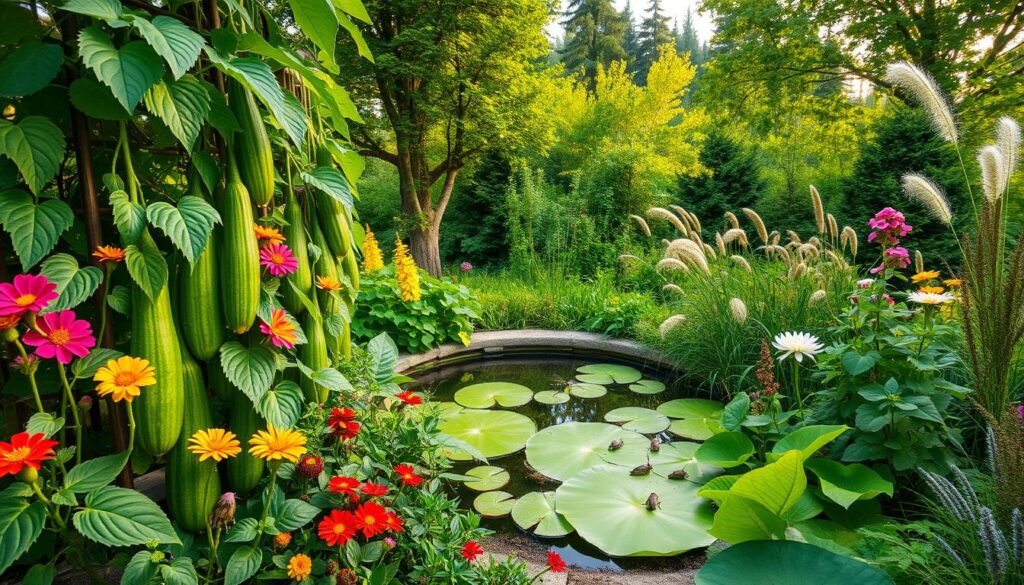
Common Pests and How Companion Plants Help
Dealing with cucumber pests can make or break your gardening experience. Knowing which pests threaten your cucumber plants, like aphids and cucumber beetles, is crucial. Fortunately, companion plants can be a natural solution to manage these issues.
Aphids and Their Natural Predators
Aphids are small but notorious cucumber pests that suck sap from plants, weakening their overall health. Companion plants such as dill and fennel attract beneficial insects like lacewings and parasitic wasps. These natural predators can help reduce the aphid population without the need for chemical pesticides.
Cucumber Beetle Prevention
Cucumber beetles pose another threat, easily damaging the leaves and flattening young fruits. Planting marigolds alongside cucumbers can deter these pests. The scent of marigolds masks the cucumber’s aroma, significantly lowering the chances of beetle attacks.
The Role of Ladybugs
Ladybugs are friendly predators that help control populations of harmful pests, including aphids. By introducing companion plants that attract ladybugs, like sweet alyssum, you create a welcoming environment for these beneficial insects. Encouraging ladybugs in your garden helps maintain balance and promote cucumber plant health.

| Pest | Companion Plant | Beneficial Insects Attracted |
|---|---|---|
| Aphids | Dill | Lacewings, Parasitic Wasps |
| Cucumber Beetles | Marigolds | None (repellent effect) |
| Aphids | Sweet Alyssum | Ladybugs |
Nutrient Requirements for Cucumbers and Companions
Successfully growing cucumbers and their companion plants depends on understanding their nutrient needs. Cucumbers benefit greatly from specific minerals, and when you choose appropriate companion plants, you can create a thriving ecosystem in your garden. This section explores the essential nutrients required for optimal growth, how soil pH affects these plants, and the best organic fertilizers for your cucumber garden.
Essential Nutrients for Growth
Cucumbers typically require vital nutrients such as nitrogen, phosphorus, and potassium. These minerals play crucial roles in plant health:
- Nitrogen: Promotes leafy growth and overall vigor.
- Phosphorus: Essential for root development and flowering.
- Potassium: Supports strong cell walls and enhances disease resistance.
When growing cucumber companion plants, it is essential to monitor the nutrient requirements to ensure a bountiful harvest.
pH Levels in Your Garden Soil
Maintaining proper soil pH is critical for nutrient absorption. Cucumbers thrive best in slightly acid to neutral soils, ideally between 6.0 and 7.0. Testing your soil pH allows you to adjust its acidity or alkalinity, ensuring your plants have optimal access to nutrients. You can improve soil pH through amendments like lime for acidic soils or sulfur for alkaline soils.
Organic Fertilizers to Consider
For a flourishing cucumber garden, using organic fertilizers can help meet the nutrient requirements for cucumber companion plants. Consider these options:
- Compost: Enriches the soil with organic matter and essential nutrients.
- Bone meal: Provides phosphorus for strong root and flower growth.
- Fish emulsion: A balanced source of nitrogen and trace minerals.
- Kelp meal: Offers potassium and trace minerals while enhancing plant vitality.
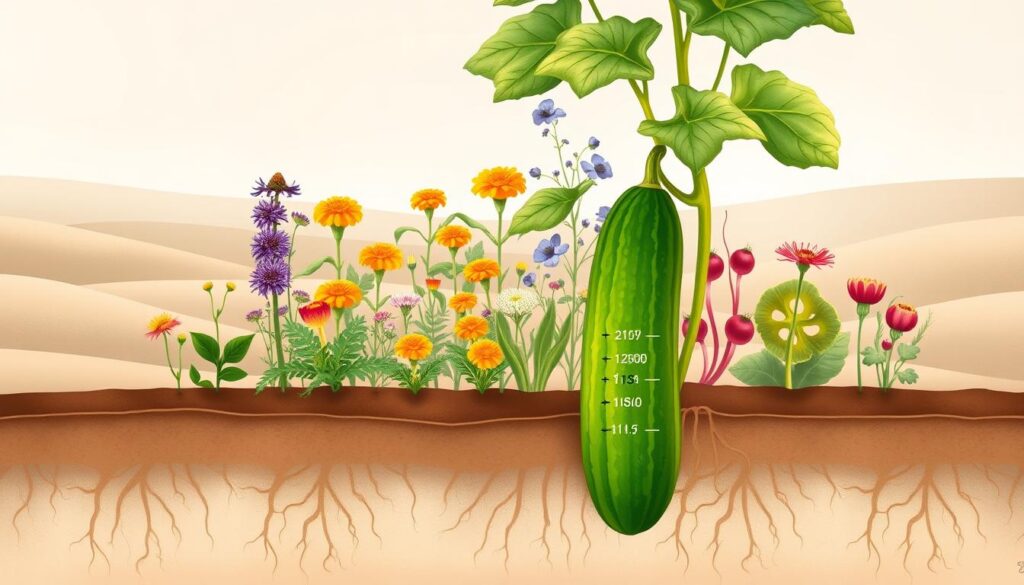
Watering Practices for Healthy Growth
Proper watering practices for cucumber plants play a critical role in their overall health and productivity. Cucumbers thrive in consistently moist soil, making it essential to understand their specific water requirements. Balancing the watering needs of companion plants also contributes to an effective growing environment. This section delves into how to meet the watering needs of cucumbers and their partners in the garden.
Understanding Cucumber Water Needs
Cucumbers enjoy moist soil, ideally receiving about one to two inches of water per week. Too little moisture can lead to stress and bitterness in the fruit, while overwatering can cause root rot. Regularly check the top inch of soil; if it’s dry, it’s time to water. Drip irrigation systems or soaker hoses offer a reliable way to ensure adequate moisture reaches the roots without oversaturating the surface.
Companion Plant Watering Considerations
When planning your garden, consider the cucumber companion plants water needs. Each plant has unique requirements that should be aligned with cucumber needs for optimal growth. For instance, plants like radishes and marigolds prefer similar moisture levels, which allows for easier irrigation management. Ensuring that you do not over or underwater also helps create a harmonious growing environment for these companions.
Mulching for Moisture Retention
Applying a layer of mulch around your cucumber plants not only suppresses weeds but also enhances soil moisture retention. Organic materials such as straw, wood chips, or grass clippings work well as mulch options. This practice minimizes evaporation and maintains an even soil temperature, benefiting both cucumbers and their companion plants. Regularly check the mulch layer, replenishing it as needed to ensure continued moisture control.

Harvesting Your Cucumbers and Their Companions
Understanding the optimal time for harvesting cucumbers is essential for maximizing your yield. Recognizing when to pick cucumbers ensures you get the best flavor and texture while also helping your companion plants thrive. Harvesting cucumbers and companion plants at the right time can enhance your overall gardening experience.
When to Harvest Cucumbers
Cucumbers are usually ready for harvest when they reach a size and color that’s characteristic of their variety. Typically, you’ll want to pick them when they are firm and have a vibrant green color. This can range from 4 to 10 inches long. If you wait too long, they may grow too large and turn yellow, which affects their taste and texture.
Understanding Companion Planting Benefits at Harvest Time
The presence of companion plants can positively influence your cucumber harvest. Not only do they help to deter pests, but they can also boost cucumber growth and health. For example, planting marigolds near your cucumbers can help reduce pest populations, allowing you to enjoy a better yield. Furthermore, companion plants can provide shade or support, enhancing the growing conditions for your cucumbers.
Preserving Your Harvest
Once you’ve harvested your cucumbers, it’s crucial to know the best cucumber preservation methods to extend their shelf life. Here are some popular methods:
- Refrigeration – Keep cucumbers in a cool, dry area of your refrigerator to maintain freshness.
- Packing in Ice – For short-term storage, nestling cucumbers in ice can keep them crisp.
- Pickling – This classic method not only preserves cucumbers but also adds amazing flavor.
- Canning – You can process cucumbers into jars using heat to eliminate bacteria.
- Freezing – Although this may change the texture, freezing cucumbers is an option if you plan to use them later in smoothies or soups.
The right combination of harvesting cucumbers and companion plants, coupled with effective cucumber preservation methods, can lead to a seamless gardening experience. Enjoy the fruits of your labor and know that proper timing and techniques can make all the difference.
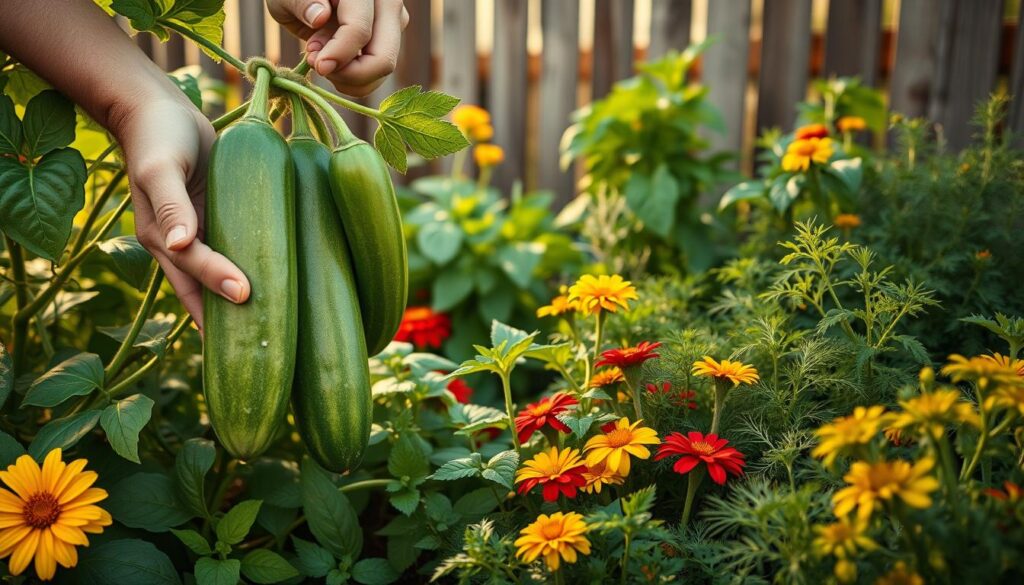
| Preservation Method | Advantages | Disadvantages |
|---|---|---|
| Refrigeration | Maintains freshness | Short-term solution |
| Packing in Ice | Great for immediate freshness | Not practical for long-term |
| Pickling | Adds flavor | Requires additional ingredients |
| Canning | Long-lasting | Time-consuming process |
| Freezing | Easy to store | May alter texture |
Seasonal Considerations for Planting
Understanding the seasonal planting for cucumbers and their companion plants can significantly enhance your gardening success. Each season presents unique opportunities and challenges that require specific strategies for optimal growth. You can ensure your garden flourishes year-round by aligning your planting and care routines with these seasonal changes.
Spring Planting Strategies
Spring marks the beginning of the gardening season. As the soil warms, it’s time to focus on planting cucumbers and their companions. Start by choosing disease-resistant cucumber varieties. Prepare your soil with organic compost to boost nutrient levels. It’s essential to include companion planting throughout the seasons, such as planting radishes or marigolds alongside cucumbers to deter pests.
Summer Care Tips for Your Garden
During the summer months, attention shifts to maintenance. Regular watering is crucial for cucumbers as they thrive in moist conditions. Pay attention to the health of companion plants, ensuring they receive adequate nutrients and space. Implement practices like mulching to retain soil moisture and promote a healthy ecosystem that benefits cucumbers and other nearby plants.
Preparing for Fall Harvests
As summer transitions into fall, it’s time to focus on harvesting your cucumbers and their companions. Monitor the ripeness of your cucumbers closely, picking them before they overgrow. In addition, evaluate your companion plants. When done correctly, these planting strategies can maximize your yield and enrich your garden’s soil for future seasons.
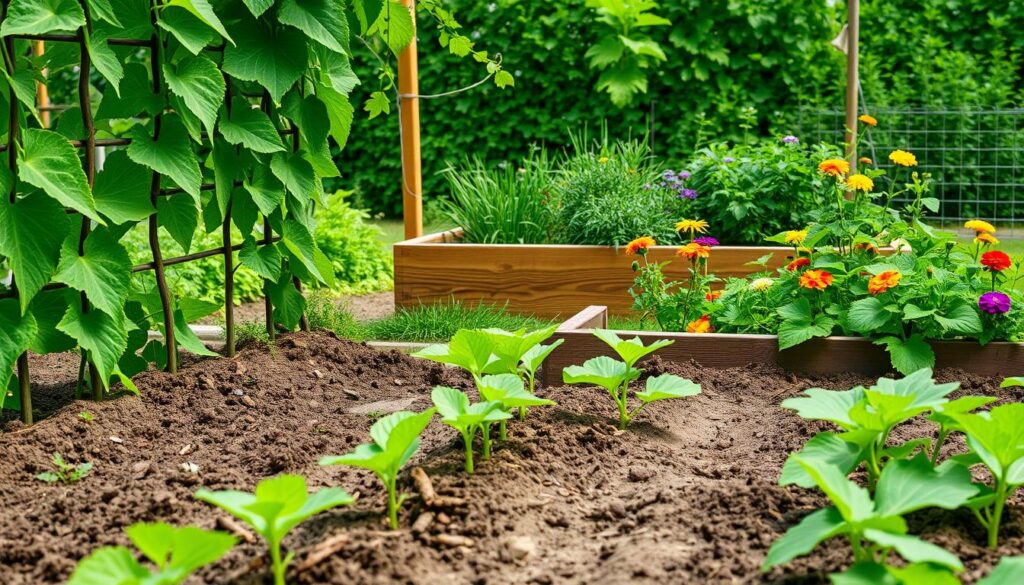
Common Mistakes to Avoid with Companion Planting
Engaging in companion planting can enhance your cucumber garden, but certain mistakes can lead to disappointment. Awareness of these mistakes to avoid when companion planting will improve your results significantly. This section covers key areas to focus on for successful and effective companion plant combinations.
Overcrowding Your Garden
One of the most common mistakes to avoid when companion planting is overcrowding. Each plant requires sufficient space to thrive and access essential nutrients. Proper spacing allows for optimal growth while minimizing competition for light and water. Utilizing a garden layout plan can help you arrange plants strategically, ensuring they coexist harmoniously.
Ignoring Pest Identification
Pests can disrupt even the most effective companion plant combinations. Failing to recognize pest symptoms can lead to larger infestations and compromised plant health. Take the time to learn about common pests in your area and their natural predators. This knowledge encourages proactive measures, such as introducing beneficial insects to keep your garden healthy and flourishing.
Neglecting Soil Health
Healthy plants begin with healthy soil. Neglecting soil health is a critical mistake to avoid when companion planting. Regular soil testing can reveal nutrient levels and pH balance. Enhancing your soil with organic matter ensures that your plants receive the nutrients they need for robust growth. Incorporate compost or other organic amendments to maintain vibrant soil conditions.
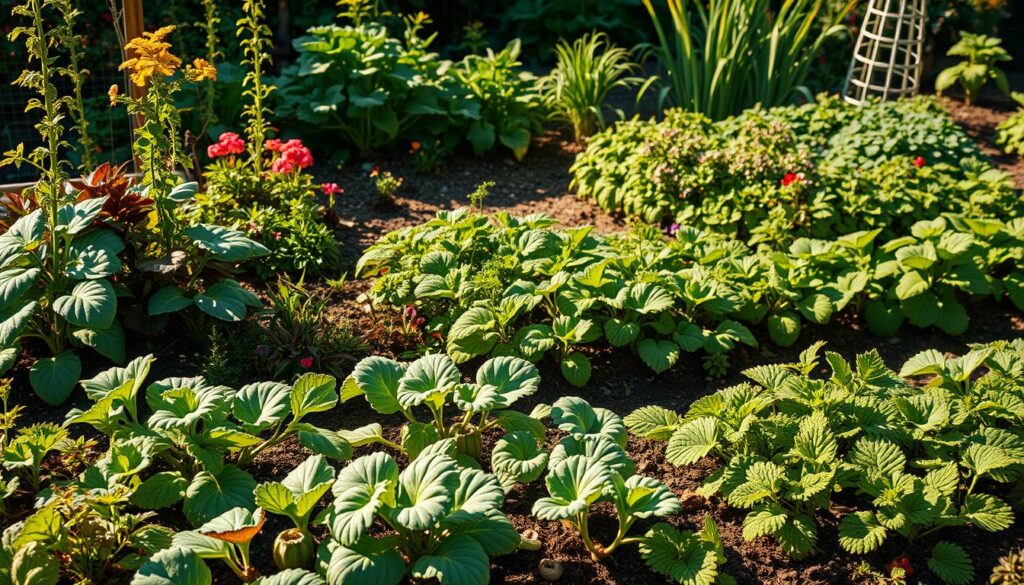
Resources for Successful Companion Planting
Mastering the art of companion planting requires access to valuable resources. A variety of tools exist to enhance your knowledge and improve your gardening practices. Books, online communities, and workshops offer diverse opportunities to learn and connect with fellow gardeners. Engaging with these resources can deepen your understanding of companion planting and help you utilize effective strategies.
Books and Guides to Explore
There are numerous books and guides dedicated to companion planting that provide an insightful overview of plant relationships, growth techniques, and strategies for successful gardening. Titles like “Carrots Love Tomatoes” and “The Vegetable Gardener’s Bible” feature sections focused on cucumber companions. Utilizing these companion planting resources can significantly elevate your gardening experience.
Online Communities for Support
Consider joining cucumber gardening support groups on platforms like Facebook, Reddit, or dedicated gardening forums. These online communities allow you to share experiences, ask questions, and receive advice from seasoned gardeners. Engaging with peers facing similar challenges can foster personal growth and enhance your gardening journey.
Workshops and Classes
Participating in local workshops and gardening classes offers hands-on learning opportunities. Many botanical gardens, co-ops, and agricultural extensions provide sessions on companion planting. Interacting with instructors and fellow participants can provide you with practical skills as well as encouragement. Connecting to such events can be invaluable as you delve into companion planting.
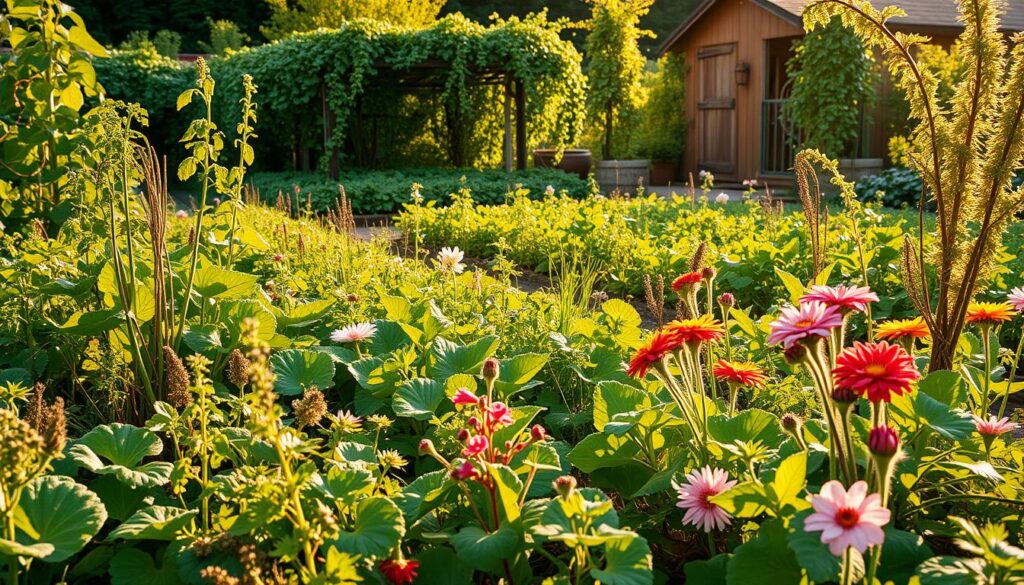
Conclusion: Enjoying the Fruits of Your Labor
The journey of companion planting not only nourishes your cucumbers but also enriches your gardening experience. You’ll find that observing your garden’s progress can be a gratifying aspect of this endeavor. Keep an eye on how your companion plants interact with each other and your cucumbers. This practice will help you better understand the benefits of cucumber companion planting, allowing you to make more informed decisions for future seasons.
As you gain confidence in your gardening skills, consider experimenting with new companion plants each season. Diversifying your garden will not only improve yields but also enhance pest control and soil health. Trying out different pairings can lead to exciting discoveries and improvements, helping you understand what works best in your unique growing environment.
Lastly, don’t forget the value of sharing gardening success with others. Talking with fellow gardening enthusiasts or participating in local gardening groups can provide you with fresh insights and encouragement. By exchanging experiences and tips, you contribute to a supportive community, ultimately enriching your gardening journey and inspiring others.
